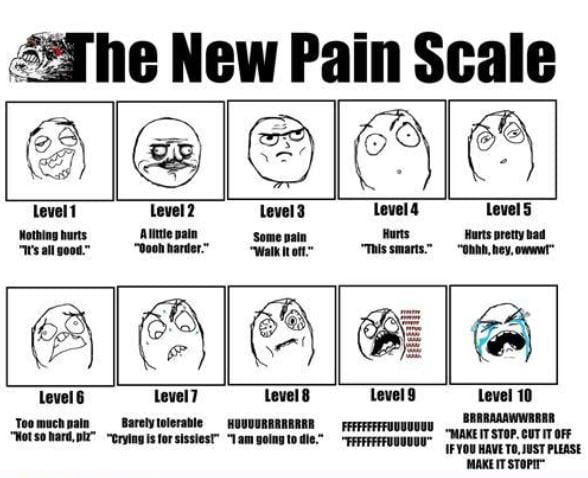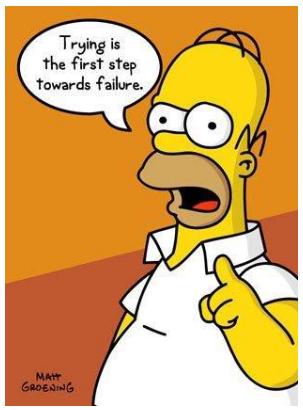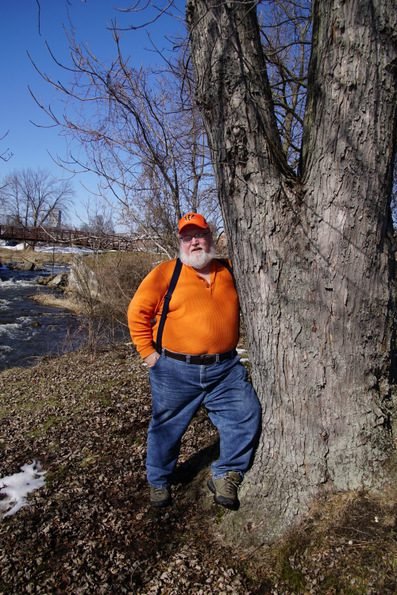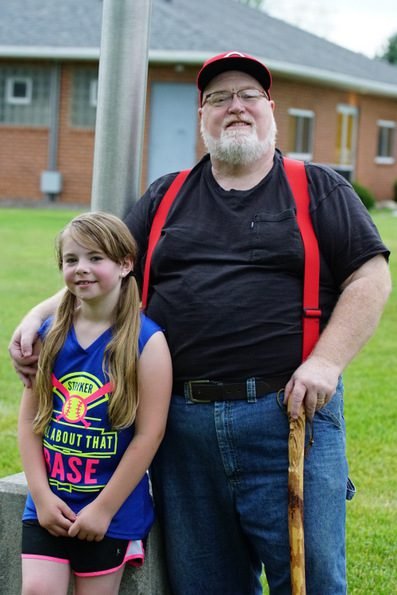
Warning! Bathroom talk ahead. If you can’t bear to read about bodily functions, it might be best if you stop reading after the story about the baseball game.
I am physically disabled. Due to muscle and joint problems — which have left me with increasing debility and pain — I always walk with a cane or use a wheelchair. Anyone who has ever seen me walk can immediately tell that I have physical problems. When entering the grocery store, people will often wait until I make it to the door and then walk in behind me. If I see that this is happening, I usually say, oh no, you go ahead. I am a slow-moving vehicle. We all have a laugh and they quickly walk through the door.
Slow-moving vehicle — that describes me well. I can’t run, bend forward more than forty to sixty degrees, and I am prone to falling, especially when I hit raised sidewalks or miss seeing that there is a step ahead. Fortunately, I have not broken anything. I have, however, pulled neck, back, and hamstring muscles, along with injuring my shoulders, knees, and ankles. Often, the greatest injury comes when I try to keep myself from falling; that moment where I tense up my body and try to stay balanced. On more than a few occasions, I have kept myself from crashing to the ground, only to be unable to get out of bed the next day because I pulled this or that muscle or wrenched this or that joint. Such is life …
It would be easy for me to throw in the towel and resign myself to never going out in public again. I have all the physical reasons necessary to justify becoming a full-time couch potato. Of course, giving in only hastens my death. I know I need to be as active as possible, so I push myself to do things that cause physical exertion and pain. Athletes often wear shirts that say No Pain, No Gain. I remember living out that mantra as a young man when I played baseball and basketball; and even as an adult athlete — well into my thirties. Today, it’s lots of pain, period.
I am now sixty-one years old. I know there is coming a day when I won’t be able to carry out even the limited things I now do. Every year brings decreased mobility. I struggle psychologically with watching my wife do many of the things I used to do. I find it embarrassing to watch Polly weed-eating the yard or doing other physical activities that were once my domain. There are times I feel less of a man when Polly does these things, but I know she’s doing them because she loves me. There are times she will do things only to make sure that I CAN’T do them, knowing that I will try to do them, causing myself increased suffering and pain.
Today, I went to a nearby golf course to shoot photographs for a local high school golf team. Two years ago, I started shooting high school sports. I take the photos free of charge. I see it as a way to give back to the local school district and to provide parents with professional quality photographs of their athlete children. I know parents appreciate the photos, and on the back end it has driven some paying business my way.
I arrived at golf course around 3:30 PM. This was my first time shooting a golf match. I was nervous about how best to photograph the golfers, what aperture and shutter speed to use, and how much walking I would need to do. As always, my sidekick, my twenty-nine year old daughter with Down syndrome, was with me. I talked to the coaches, learning how the players would play the course. I thought, man I really need to rent a cart. (I always pay my own freight, be it tickets or golf cart rentals.) I went in the clubhouse to inquire about a cart, only to find out none was available.
As I exited the clubhouse, a man came up to me and said, Bruce, is that you? I paused for a moment, and then he gave me his name. He was my last pastor, a young United Methodist cleric whom I really liked. He and I had numerous conversations about theology, history, and life. Both he and his wife were delightful people to be around. I thought he and his family had moved away a couple years ago, but discovered they still lived in the area and their two oldest sons were on the golf team. We had a delightful talk, and I was reminded of how much I missed talking to him.
While we were talking, several golfers finished their round and returned their carts. The wife of my former pastor said, Bruce, you ought to see if they have a cart for you. Good idea, I thought. I went into the clubhouse and inquired as to cart availability. The girl taking care of cart rentals said, yes, two carts just came in. I told her, great! I am here to photograph the match for __________ school. She had me sign the rental sheet, and then said the cart would be free of charge. Come to find out, unbeknownst to both of us, the owner/manager of the course had promised my cart to one of the coaches.
I took the key for the cart, and off I went to the tee for the first hole and the green for the ninth hole. I had planned to drive to the other holes, hoping to catch all the school’s players in action. One of the coaches told me that the groups were staggered, so everyone one of them would eventually end up either driving off the tee for the first hole or putting on the green of the ninth hole.
As I was standing, waiting for match to begin, I chatted with one of coaches, the aforementioned pastor and his wife, and a photographer for the local newspaper. This was the first time the coach and I had any sort of extended conversation — light chit-chat as we awaited the start of the match. As we were talking, the manager/owner came up and joined our group. He let it be known that my cart was the coach’s cart. I replied, no it is mine. He said, no it’s not. Did you pay for it? That cart belongs to the coach. I reserved it for him. Confused, I replied, the girl up at the clubhouse gave me the cart. I am here to photograph the match for ______________. The manager/owner, with a stern face, replied, I didn’t know that. No apology, no sorry for the misunderstanding or let me see what I can work out.
The coach let it be known that he was fine with me having the cart. Once I determined I could do what I needed to do without the cart, I went to the coach and said, here you can have the cart, I’ll be fine. The coach knew I was disabled. He coaches several other sports I have photographed. He said, are you sure? I replied, yep, and then made a joke about having a stroke and his name being the last words on my lips.
After an hour or so, I found myself quite fatigued, so I decided to call it a day. I went to the clubhouse to let the girl who handles the rentals know that I had given the cart to _____________. I then told her that the owner/manager thoroughly embarrassed me in public. I explained to her what happened and recounted what he said. She had no idea the cart was reserved for the coach (who, by the way, said if he got a cart he would chauffeur me from hole to hole). She asked if I wanted to talk to manager/owner. Still angry over his words, I replied, no, he’s an asshole and that’s all I need to know. She profusely apologized, but I stopped her, saying, hey it wasn’t your fault, it was his. As is often the case, low-level employees feel the brunt of criticisms over things they had nothing to do with. I always make sure to let them know that my ire and dissatisfaction is directed at the offender, and not them.
Several weeks ago, Polly and I, along with Bethany, attended a Toledo Mud Hens/Louisville Bats baseball game. Two of our sons and their children were also at the game. I was quite fatigued before the start of the game, and by the end — due to the heat and humidity — I felt quite distressed physically. Thanks to my failure to take care of myself and drink enough fluids, I began to notice the symptoms of heat exhaustion. The game was nearing its conclusion, but there were fireworks afterward and we wanted to see them. I turned to Polly and said, We really need to go. I’m sorry, but I really feel sick: light-headed, clammy, weak.
I told my children I wasn’t feeling well, and then we made the long, arduous climb to the concourse. By the time I reached the peak of Mount Kilimanjaro, I was short of breath and could hardly walk. I had a momentary thought of telling Polly that I needed medical attention, but I thought, we are parked close by, and I if I take it slowly — as a turtle “running” across the road — I will make it to our car.
I finally made it to the exit, thinking, I made it. All I have to do cross the street, walk a couple of hundred of feet, and sweet, wonderful, life-saving air conditioning awaits me. I noticed a Toledo police officer was blocking the street and forcing people to walk elsewhere (due to the fireworks). I thought, the car is right there. I can see the ship on the horizon, deliverance draws nigh.
Polly was walking behind me with Bethany, and unbeknownst to me, she decided to walk to the corner and cross the street. I went up to the officer and said, I am really, really sick. I would like to cross the street here so I can quickly get to the car. He replied, what’s wrong with you? At that moment, I wanted to, with what meager strength I had left, scream at the officer. Instead I told him I was really sick; that I felt weak and clammy. If the officer had bothered to LOOK at me, he would have noticed that I was profusely sweating; that my shirt, ball cap, and pants were soaked with sweat; that I was walking with f-u-i-c-k-i-n-g cane. Instead, he replied, if you are so sick, how come no one is helping you? I turned, thinking Polly was behind me, only to find out she was half a city block away, crossing the street at the crosswalk. I told the officer, that my “help” was at the street corner. Look I am really, really sick, I said. I just need to get to my car. The officer looked at me with a stern face, one that said, I don’t believe a word you are saying, and said, Go on… (meaning cross the street). For a brief moment, I thought about dropping over in the street from exhaustion, thus proving the point that I really was sick. Instead, I slowly motored on, reaching the car just as Polly arrived with the keys. She unlocked the doors, and I collapsed into the passenger’s front seat. Polly quickly started the car and turned on the air conditioning. I stripped off my sweat-filled shirt and hat and tossed them into the back seat. I made it, I told myself, knowing that I had pushed myself too hard and that I could have collapsed from heat exhaustion. Lesson learned — maybe.
Last weekend, Polly and I, along with Sinnuh (my latest nickname for Bethany, a corruption of the word Sinner, from the hit TV show on the USA Network) went to the Henry County Fair. We planned to tour the grounds and then watch the tractor pull. We found good seats and settled in to watch turbocharged, fuel-injected 1,800 horsepower machines see how far they could pull a weight sled. A perfect night for me: loud tractors and the smell of alcohol fuel; much like the smells at the dirt tracks I frequent.
An hour or so into the show, I felt THAT. I said to myself, no, please God no, not THAT! As is God’s custom, he was nowhere to be found. I turned to Polly and said, I need to use the bathroom. She replied, okay. I told her, not that kind of using the bathroom. I am all cramped up. She looked at me with lugubriousness, knowing how fearful I was of using public bathrooms to take a shit. This, by far, is the one thing I fear the most. Dirty toilets, single-ply toilet paper, lack of privacy, did I mention dirty toilets? I get distressed just thinking about having to use a public toilet.
I always try to make sure my bladder and intestinal tract are empty before I go to a public event. When I left the house, I thought I was good to go, or better put good not to go. Unfortunately, I will occasionally have what I call the mother of all shits — an experience I don’t wish on anyone. I can “feel” when one is coming on, and that’s exactly what I felt at the tractor pull.
As I stood to make my way down to the concourse, I let out a big fart. I am sure the people behind me thought, OH MY GOD. I, one the other hand, was grateful that it was gas and not fecal matter. Built back in the days when privacy and handicapped access were not important, the bathrooms were under the grandstands. I knew using the toilet was going to be an adventure; adventure as in having to spend the day with Donald Trump. Not g-o-o-d.

Waves of cramps let me know that I better find the bathroom soon. I entered the bathroom, looked at no one (it’s a man thing) and made my way to the farthest stall. Finally, I thought, I made it. I quickly dropped my pants, checked the toilet seat for pee, and boom all of Polly’s wonderful cooking — and three crunchy tacos from Taco Bell — exited my body. The stall door had no latch, so as I sat there doing my business, I held the door shut with the handle of my cane. I hoped that the busy kids who entered the bathroom would see my cane and not try to expose Santa in all his glory.
I sat there for a few minutes, reading emails on my phone and letting my muscles relax. I stood up to wipe my ass, only to find out that the toilet paper was the cheapest single-ply toilet paper you could buy. Awful stuff. A sure guarantee that you will end up with shit on your fingers. Worse yet, the stall walls only came half way up my chest. Here I was, leaning against the plywood stall wall so I could wipe my ass — which is an ordeal in and of itself — looking as if I was peering over into the next stall, breaking the cardinal man-club rule: no looking. (Due to a loss of mobility, cleaning up after defecating is quite challenging. The doctor suggested Polly could help. I told him point blank, my wife is never going to wipe my ass. NEVER! I would rather be dead than have her do that for me!) Finally, I pulled up my pants, only to find out that my suspenders were wet and stained from lying on the pee-soaked floor. After a few moments of reflective cussing, I got myself together, ready to watch the next class of tractors.
Just as I was getting ready to exit the stall, my bowels said, oh no you don’t big boy. A sluggish meal had finally made it to my sphincter muscle and it was demanding exit. I thought, @#$%#@, really? Yes, really. And so, knowing the sluggish meal would not wait, down went my pants, down went my ass on an undersized, low-profile toilet, and down went the last contents of my bowel. I once again read my email and approved comments as I waited for the physical calm to come. Finally, it arrived, and I stood, gathered up a long strand of single-ply toilet paper, tripled it over, attempted to make my ass look presentable, pulled up my pants, zipped them, pulled my pee-stained suspenders over my shoulders, and exited the stall. I made my way back to the grandstand, telling Polly that I had the mother of all bowel movements, and that my pants and suspenders will definitely need washed. We looked at each other, smiled, laughed a bit, realizing that this was just another day in the life and times of Bruce Gerencser.
Share This Post On Social Media:







 What follows is a letter I wrote several days ago to the athletic director at
What follows is a letter I wrote several days ago to the athletic director at 






